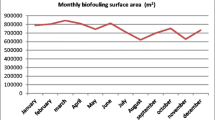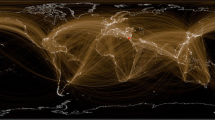Abstract
Commercial ships inadvertently transfer vast numbers of living organisms beyond their evolutionary ranges, sometimes resulting in invasions of distant marine habitats. Biofouling on ship hulls translocate organisms that cling to the undersides and interstices of ships that function as hard substrate habitat for biota. Because biofouling accumulates over space and time continually, it poses risk to all ports visited. To better understand the potential magnitude of the biofouling vector in the United States, we compiled information on ship-specific dimensions as well as actual arrival histories of the fleets of ships calling at U.S. ports (2011–2014) in an effort to calculate wetted surface area (WSA) flux to the U.S. The annual mean flux of WSA from overseas bioregions to the U.S. is 333 km2 year−1. An additional 177 km2 year−1 of WSA moves among the eight distinct biogeographic regions of the lower 48 United States. We confirm that over 90% of all global marine bioregions (120 of 132 identified by IUCN) are visited by commercial ships within five port calls of arriving to the U.S. Our analysis is the first ever to quantify the extent of WSA flux among global marine bioregions and underscores the urgent need for management approaches and technologies that will reduce associated invasion risks.




Similar content being viewed by others
References
Ashton GV, Davidson IC, Geller J, Ruiz GM (2016) Disentangling the biogeography of ship biofouling: barnacles in the Northeast Pacific. Glob Ecol Biogeogr 25(6):739–750. https://doi.org/10.1111/geb.12450
Atwood WG, Johnson AA (1924) Marine structures, their deterioration and preservation. Report of the Committee on Marine Piling Investigations of the Division of Engineering and Industrial Research of the National Research Council, National Research Council, Washington, DC
Callow ME, Callow JA (2002) Marine biofouling: a sticky problem. Biologist 48:1–5
Carlton JT (1985) Transoceanic and interoceanic dispersal of coastal marine organisms: the biology of ballast water. Oceanogr Mar Biol 23:313–371
Carlton JT (2001) Introduced species in the U.S. coastal waters: environmental impacts and management priorities. Pew Ocean Commission, Virginia
Coutts ADM, Dodgshun TJ (2007) The nature and extent of organisms in vessel sea-chests: a protected mechanism for marine bioinvasions. Mar Pollut Bull 54:875–886
Coutts ADM, Taylor MD (2004) A preliminary investigation of biosecurity risks associated with biofouling on merchant vessels in New Zealand. New Zeal J Mar Fresh 38:215–229
Dafforn KA, Lewis JA, Johnston EL (2011) Antifouling strategies: history and regulation, ecological impacts and mitigation. Mar Pollut Bull 62:453–465
Darling JA, Herborg L-M, Davidson IC (2012) Intracoastal shipping drives patterns of regional population expansion by an invasive marine invertebrate. Ecol Evol 2:2552–2561
Darwin C (1854) A monograph of the sub-class Cirripedia: the Balanidae. Ray Society, London
Davidson IC, Simkanin C (2012) The biology of ballast water 25 years later. Biol Invasions 14:9–13
Davidson IC, Brown CW, Sytsma MD, Ruiz GM (2009) The role of containerships as transfer mechanisms of marine biofouling species. Biofouling 25(7):645–655
Davidson I, Scianni C, Hewitt C, Everett R, Holm E, Tamburri M, Ruiz G (2016) Mini-review: assessing the drivers of ship biofouling management—aligning industry and biosecurity goals. Biofouling 32:411–428
Floerl O (2014) Management challenges and opportunities for marine biosecurity in the Arctic. In: Fernandez L, Kaiser BA, Vestergaard N (eds) Marine invasive species in the Arctic, TemaNord 2014:547. Nordic Council of Ministers, Copenhagen, pp 57–67
Fofonoff PW, Ruiz GM, Steves B, Carlton JT (2003) In ships or on ships? Mechanisms of transfer and invasion for nonnative species to the coasts of North America. In: Ruiz GM, Carlton JT (eds) Invasive species: vectors and management strategies. Island Press, Washington, pp 152–182
Galil BS, Boero F, Campbell ML, Carlton JT, Cook E, Fraschetti S, Gollasch S, Hewitt CL, Jelmert A, Macpherson E, Marchini A (2015) Double trouble’: the expansion of the Suez Canal and marine bioinvasions in the Mediterranean Sea. Biol Invasions 17(4):973–976
Godwin LS (2003) Hull fouling of maritime vessels as a pathway for marine species invasions to the Hawaiian Islands. Biofouling 19:123–131
Gollasch S (2002) The importance of ship hull fouling as a vector of species introductions into the North Sea. Biofouling 18:105–121
Gotzek D, Axen HJ, Suarez AV, Cahan SH, Shoemaker D (2015) Global invasion history of the tropical fire ant: a stowaway on the first global trade routes. Mol Ecol 24:374–388
Hewitt CL, Campbell M (2010) The relative contribution of vectors to the introduction and translocation of marine invasive species. Commissioned by the Department of Agriculture, Fisheries and Forestry, Canberra
Hewitt CL, Gollasch S, Minchin D (2009) The vessel as a vector—biofouling, ballast water and sediments. In: Rilov G, Crooks JA (eds) Biological invasions in marine ecosystems: ecological, management, and geographic perspectives. Springer, Berlin, pp 117–131
Hughes Martiny JB, Bohannan BLM, Brown JH, Colwell RK, Fuhrman JA, Green JL, Horner-Devine MC, Kane M, Adams Krumins J, Kuske CR, Morin PR, Naeem S, Øvreås L, Reyensenbach AL, Smith VH, Staley JT (2006) Microbial biogeography: putting microorganisms on the map. Nat Rev Microbiol 4:102–111
Hunsucker ZK, Koka A, Lund G, Swain G (2014) Diatom community structure on in-service cruise ship hulls. Biofouling 30:1133–1140. IHS Maritime World Shipping Encyclopedia https://www.ihs.com/products/maritime-world-shipping-encyclopedia.html
IMO (2001) International convention on the control of harmful antifouling systems on ships. International Maritime Organization, London
IMO (2011) International Maritime Organization: Guidelines for the control and management of ships’ biofouling to minimize the transfer of invasive aquatic species. Marine Environment Protection Committee, Annex 26, Resolution MEPC.207 (62). International Maritime Organization, London
Inglis GJ, Floerl O, Ahyong S, Cox S, Unwin M, Ponder-Sutton A, Seaward K, Kospartov M, Read G, Gordon D et al (2010) The biosecurity risks associated with biofouling on international vessels arriving in New Zealand: summary of the patterns and predictors of fouling. Report to the Ministry of Agriculture and Forestry, Biosecurity New Zealand, Wellington
Kaluza P, Kölzsch A, Gastner MT, Blasius B (2010) The complex network of global cargo ship movements. J R Soc Interface. https://doi.org/10.1098/rsif.2009.0495
Kelleher G, Bleakley C, Wells S (1995) A global representative system of marine protected areas, vol 2-4. Great Barrier Reef Marine Park Authority, World Bank, IUCN (World Conservation Union), Washington
Keller RP, Drake JM, Drew MB, Lodge DM (2011) Linking environmental conditions and ship movements to estimate invasive species transport across the global shipping network. Divers Distrib 17:93–102
Leary DH, Li RW, Hamdan LJ, Hervey WJ IV, Lebedev N, Wang Z, Deschamps JR, Kusterbeck AW, Vora GJ (2014) Integrated metagenomic and metaproteomic analyses of marine biofilm communities. Biofouling 30:1211–1223
McClay T, Zabin C, Davidson I, Young R, Elam D (2015) Vessel biofouling prevention and management options report. Report to the US Coast Guard Research & Development Center. New London, CT
Miller AW (2014) Melting sea ice, accelerated shipping, and arctic invasions. In: Fernandez L, Kaiser BA, Vestergaard N (eds) Marine invasive species in the Arctic, TemaNord 2014:547, Nordic Council of Ministers, Copenhagen, pp 35–55
Miller AW, Ruiz GM (2014) Arctic shipping and marine invaders. Nat Clim Change 4:413–416
Miller AW, Minton MS, Ruiz GM (2011) Geographic limitations and regional differences in ships’ ballast water management to reduce marine invasions in the contiguous U.S. Bioscience 61:880–887
Minchin D (2006) The transport and the spread of living aquatic species. In: Davenport J, Davenport JL (eds) The ecology of transportation, managing mobility for the environment. Springer, Berlin, pp 77–97
Minchin D, Gollasch S (2003) Fouling and ships hulls: how changing circumstances and spawning events may result in the spread of exotic species. Biofouling 19:111–122
Minton MS, Verling E, Miller AW, Ruiz GM (2005) Reducing propagule supply and coastal invasion via ships: effects of emerging strategies. Front Ecol Environ 3:304–308
Moser CS, Wier T, Grant JF, First MR, Tamburri MN, Ruiz GM, Miller AW, Drake LA (2016) Quantifying the total wetted surface area of the world fleet: a first step in determining the potential extent of ships’ biofouling. Biol Invasions 18:265–277
Moser CS, Wier TP, First MR, Grant JF, Riley SC, Robbins-Wamsley SH, Tamburri MN, Ruiz GM, Miller AW, Drake LA (2017) Quantifying the extent of niche areas in the global fleet of commercial ships: the potential for “super-hot spots” of biofouling. Biol Invasions 19:1745–1759
Muirhead JR, Minton MS, Miller AW, Ruiz GM (2015) Projected effects of the Panama Canal expansion on shipping traffic and biological invasions. Divers Distrib 21(1):75–87. https://doi.org/10.1111/ddi.12260
National Ballast Information Clearinghouse (2015) NBIC Online Database. Electronic publication, Smithsonian Environmental Research Center & United States Coast Guard. Available from http://dx.doi.org/10.5479/data.serc.nbic. Accessed 09 Sept 2015
Nehring S (2001) After the TBT era: alternative anti-fouling paints and their ecological risks. Senck Marit 31(2):341–351
New Zealand Government (2014) Craft risk management standards: biofouling on vessels arriving to New Zealand. New Zealand Ministry of Primary Industries, Wellington
Reid PC, Johns DG, Edwards M, Starr M, Poulin M, Snoeijs P (2007) A biological consequence of reducing Arctic ice cover: arrival of the Pacific diatom Neodenticula seminae in the North Atlantic for the first time in 800,000 years. Glob Change Biol 13:1910–1921
Rodrigue JP, Comtois C, Slack B (2013) The Geography of Transport Systems, Hofstra University, Department of Global Studies & Geography Website. http://people.hofstra.edu/geotrans. Accessed 15 June 2016
Ruiz GM, Fofonoff PW, Carlton JT, Wonham MJ, Hines AH (2000) Invasion of coastal marine communities in North America: apparent patterns, processes, and biases. Annu Rev Ecol Syst 2000:481–531
Ruiz GM, Fofonoff PW, Steves B, Foss SF, Shiba SN (2011) Marine invasion history and vector analysis of California: a hotspot for western North America. Divers Distrib 17:362–373
Schultz MP, Swain GW (2009) The influence of biofilms on skin friction drag. Biofouling 15(1–3):129–139
Schultz MP, Bendick JA, Holm ER, Hertel WM (2011) Economic impact of biofouling on a naval surface ship. Biofouling 27:87–98
Sylvester F, Kalaci O, Leung B, Lacoursiere-Roussel A, Clarke-Murray C, Choi FM, Bravo MA, Therriault TW, MacIsaac HJ (2011) Hull fouling as an invasion vector: can simple models explain a complex problem? J Appl Ecol 48:415–423
Takata L, Dobroski N, Scianni C, Falkner M (2011) Biennial report on the California marine invasive species program. Report to the California State Legislature. Sacramento, California
Thomason JC (2010) Fouling and shipping: data-mining the world’s largest antifouling archive. In: Durr S, Thomason JC (eds) Biofouling. Blackwell, Oxford
Van Maanen JD, Van Oossanen P (1988) Resistance. In: Lewis EV (ed) Principles of naval architecture, volume II. The Society of Naval Architects and Engineers, Jersey City, pp 1–93
Wells F, Booth G (2012) Setting a new benchmark in managing biofouling on vessels in a sensitive marine environment. SPE/APPEA international conference on health, safety, and environment in oil and gas exploration and production. SPE conference paper—2012, 156749-MS. Society of Petroleum Engineers
33 C.F.R Section 151.2015 (2018) Part 151—Vessels carrying oil, noxious liquid substances, garbage, municipal or commercial waste, and ballast water, Chap 1. Code of Federal Regulations 258-306
Acknowledgements
This work was partially supported by funding from the Smithsonian Institution (AWM, ICD, MSM, BS). Funding from University of Maryland Center for Environmental Science/Maritime Environmental Research Center (funding agreement 2012-38) and the U.S. Maritime Administration provided additional support (LAD, CSM). We thank Mario Tamburri (MERC/UMCES) and Carolyn Junemann (MARAD) for their guidance and programmatic support.
Author information
Authors and Affiliations
Corresponding author
Electronic supplementary material
Below is the link to the electronic supplementary material.
Rights and permissions
About this article
Cite this article
Miller, A.W., Davidson, I.C., Minton, M.S. et al. Evaluation of wetted surface area of commercial ships as biofouling habitat flux to the United States. Biol Invasions 20, 1977–1990 (2018). https://doi.org/10.1007/s10530-018-1672-9
Received:
Accepted:
Published:
Issue Date:
DOI: https://doi.org/10.1007/s10530-018-1672-9




